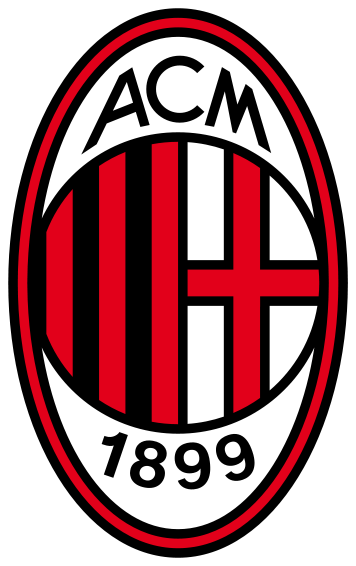
[ad_1]
AC Milan have undergone somewhat of an unexpected revival this season, transforming themselves into surprise contenders for the Scudetto whilst also performing admirably in the Europa League as well. Stefano Pioli is no doubt slowly but surely steering the Rossoneri back to European prominence, with a free-flowing attacking mantra that make Milan thrilling to watch.
However, with a clash against Manchester United on the horizon and Inter stealing the role of front-runners in Serie A, the upcoming weeks are crucial to any potential successes this season. As such, this piece will look to produce a detailed breakdown of Milan’s tactical approaches and consider whether they really have the prowess to compete with the European elite once more.
Variations in Build-Up
There are a variety of strategies that Milan use in their build-up in order to disrupt and displace the opposition, though it is most pertinent to begin with their most simplistic strategy.
As shown below, with Donnarumma in possession centrally, Kjær splits into a position on a horizontal line with Donnarumma, yet just outside the area to provide an option to receive as Zapata engages with a positional press rather than pressing to regain, whilst Kalulu takes up a slightly narrower and higher position. At the same time, Hernández and Calabria as full-backs drop deeper (much deeper than usual in Hernández’s case) to draw out Atalanta, with Hateboer and Freuler the nearest-men respectively.
Using this as the trigger, Kessie drops onto the edge of the box as a single-pivot to play a pass around the corner to escape the first phase of Atalanta’s press. If in this instance Zapata was able to cover Kjær’s wider movement, then Kessie can simply bounce back to Donnarumma and retain possession, though critically his closed body orientation does limit him from opening up to play forwards if de Roon fails to track him effectively. Meanwhile, Tonali moves in the opposite direction and onto a higher midfield line with Leão in central areas. The important knock-on effect of Milan’s deeper positioning is that Castillejo and Meite have to stay in wider positions to maintain the pitch’s width in forward areas whilst also attempting to fix Atalanta’s wing-backs to heighten the advantage that Milan are looking to develop in central areas (as is natural this was more successful on the near-side of possession, on the opposite side Hateboer was still able to maintain a position to press both Hernández and cover Castillejo with Toloi able to travel upon Castillejo in deeper areas as well).
This means upon Kjær receiving from Kessie, Atalanta’s first pressing line has been bypassed and Kjær can look to play forwards into Milan’s second or third line. However, more importantly with Kessie dropping deeper and successfully drawing out de Roon, it results in Milan creating a direct 2v1 against Atalanta’s remaining central-midfielder (Pessina) and also creating a vast amount of vacant space for players to drop into and receive.
Ibrahimović takes up this opportunity, with the distance between Tonali and Leão creating an opportunity for him to drop in and link-up in a deeper central position. This has two potential positive outcomes, if Atalanta’s centre-backs refuse to follow Ibrahimović, he can receive without pressure and continue Milan’s attacking momentum, though if he is tracked (as Romero does) it provides the opportunity to either bounce into a 3rd man run from the deeper Kessie who can then play forwards or attempt to link-up with the closely positioned Leão, either of which draw Atalanta’s compact centre-backs out of structure. This presents Milan with a useful strategy to escape a man-orientated press, with some simple vertical movements.
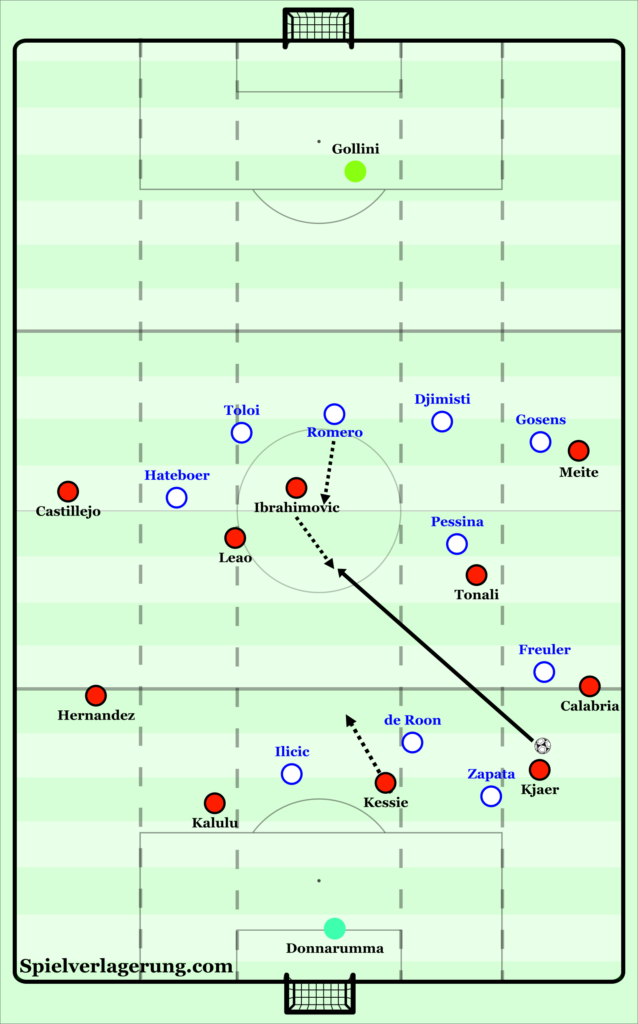
Milan also have further adaptations to build play against differing opposition, with their game against an aggressive Spezia side a good example of their build-up within a 3-3-4 structure, whilst also exemplifying limitations of Milan’s play against intelligent and aggressive pressing approaches.
Upon the trigger of a horizontal pass between centre-backs, Bennacer dropped into the back-line and made a temporary back-three (as is regularly seen throughout Europe). This allowed Bennacer with a greater technical ability than Kjær/Romagnoli to drop into a position with more perception of the game ahead and attempt to play into central areas that were congested by Spezia, whilst it also provided more depth/width for the trio to retain possession between themselves.
However, the more intriguing tactical manipulation is the extreme height and width of Hernández/Dalot at full-back who take up positions along Spezia’s last line upon Bennacer dropping in (creating a 4v4, if not 4v3 with Bastoni in a narrower position rather than tracking Dalot man-man). This consequently pushed Saelemaekers and Leão narrower, with Leão in particular re-creating the three man midfield lost by Bennacer’s movement into a back-three, whilst Saelemaekers stays high yet within the right half-space as a result of Dalot’s higher positioning.
As such, with Bennacer’s movement drawing out Ricci, it creates a 3v2 against Spezia’s central-midfield (albeit in very tight areas) from which the potency extends even further when considering that both Çalhanoğlu and Leão are positioned beyond Spezia’s midfield and would easily give Milan an overload in their attack if they were able to receive. If Ricci remained, it would have preserved equal numbers in central-midfield, but Spezia had another plan and as expected Bennacer played into Leão.
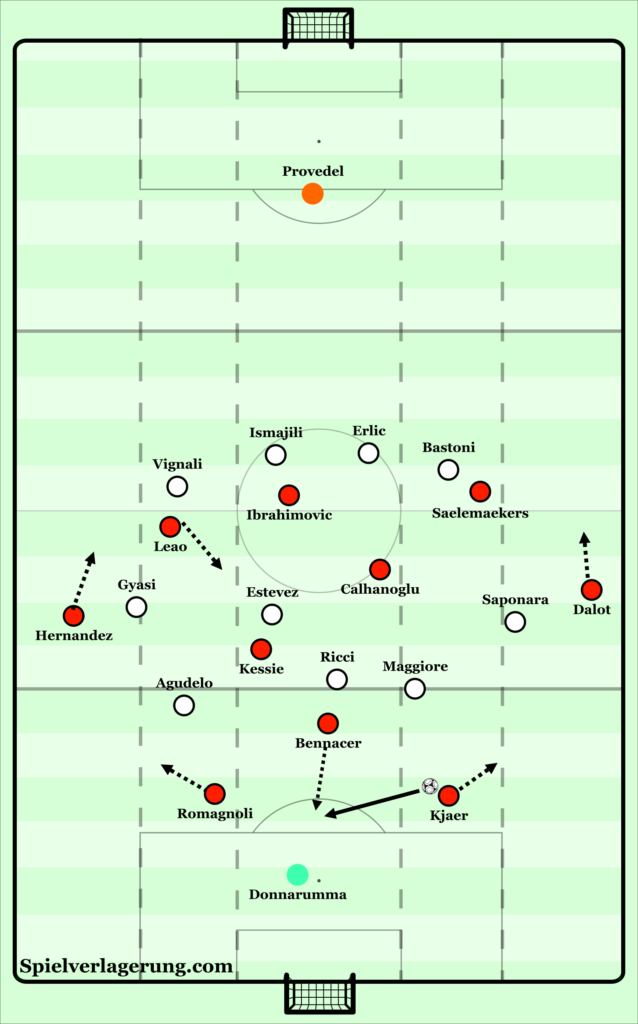
Upon the pass travelling into Leão, in an unusual tactic, both Spezia’s near-side full-back (Vignali) and far-side centre-back (Erlić) stepped into midfield to engage aggressively with Leão and Çalhanoğlu respectively, once again restoring Spezia’s numerical advantage and providing them with a basis to regain possession. If Leão was able to beat Vignali or combine with the nearby Milan players, Spezia would have been exposed with only two remaining in their last-line, exemplifying the boldness of their approach.
However, in practice their boldness reaped rewards as with immediate pressure from behind, Leão was forced to close off his body and was prevented from advancing forwards whilst recovering Spezia players blocked off passes into Romagnoli and Bennacer by keeping them in their cover-shadow, meaning Spezia could press upon Leão’s next pass into Kessie and enable them opportunities to regain possession (whilst Kjær also remained a viable passing option that Spezia could also travel to press). The importance of Spezia’s players restricting options in this manner was crucial, as not only did it allow them to press in central areas to regain, but if Milan were allowed the freedom to play backwards they would have easily waited and recycled possession until a suitable opportunity to play forwards presented itself.
Also, the value of Gyasi remaining in a man-man orientation with Hernández (similarly with Bastoni and Dalot on the opposite side) was essential as if Hernández was allowed any space to receive and combine it would have provided an escape from Spezia’s central-focused press. As a consequence, Milan found themselves increasingly unable to play through central areas into midfield with a significant amount of turnovers evidencing this.
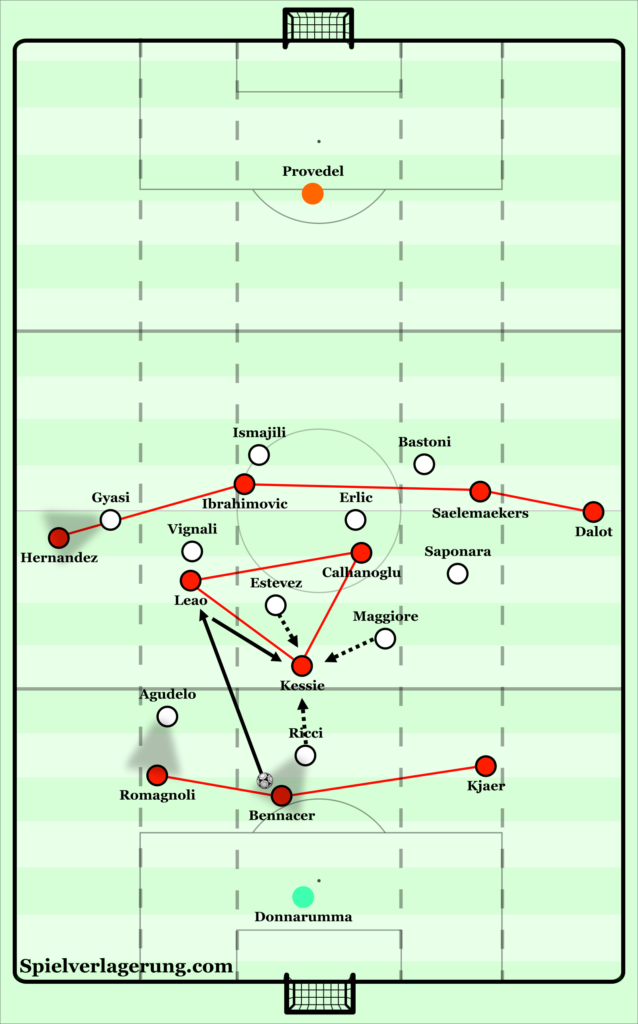
However, Milan adapted their build-up using this system to escape the central pressure with a fairly good amount of success, using Dalot in the back-three in a deeper role and accordingly shifting the positional responsibilities of more advanced players to escape via wide areas.
As shown below, using the narrower position of Kjær as the cue to drop into a back-three, Dalot receives from Kjær which subsequently draws pressure from Saponara (as we know is locked-onto Dalot in a man-orientated pressing role). If Saponara refused to follow Dalot the opportunity for Milan to manipulate Spezia and escape from wider areas would be lost, yet it is was evident from the early stages of the game that it wasn’t Spezia’s intention to do this.
Away from possession, Milan’s midfield and last-line remains in similar positions to the prior 3-3-4 build-up example, with the slight discrepancy of Leão taking up a position on Spezia’s last-line with Bennacer/Kessie/Çalhanoğlu making the midfield trio. However, due to the manipulation of players and Çalhanoğlu’s position beyond the midfield line, if Çalhanoğlu was able to receive during this phase of Milan’s play he would be unopposed as Leão/Ibrahimović have locked-off Spezia’s centre-backs centrally, preventing the pressure from behind as seen previously. Although, this wasn’t available directly from the back-three as the cover-shadow of either Ricci/Estévez often restricted this (even if it appeared to be inadvertent).
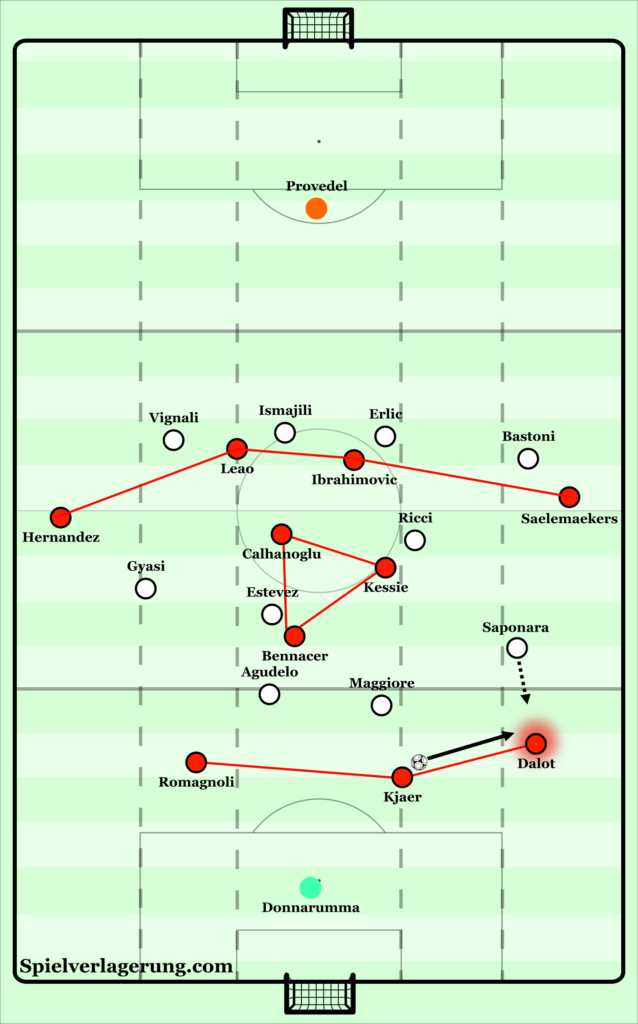
Therefore, upon Dalot receiving, with a straight pressing run from Saponara failing to restrict any nearby passing lanes, Saelemaekers dropped in to receive and provide a route to play through midfield. Despite him being under pressure from behind, his technical ability allowed him to snap possession inside on the front foot and created a 4v3 in midfield (appreciating the pressure that remains upon him from Bastoni).
Therefore, this presents Milan with the opportunity to utilise this overload and play into the potential 3v3 that remains along Spezia’s last-line with Hernández/Leão/Ibrahimović all in a position to generate a dangerous attack. But, Spezia’s aggressive press limited these eventualities to an extent for Milan who lacked quality throughout this match in honesty, yet it does present an intelligent way to combat opponents who are structured in this manner.
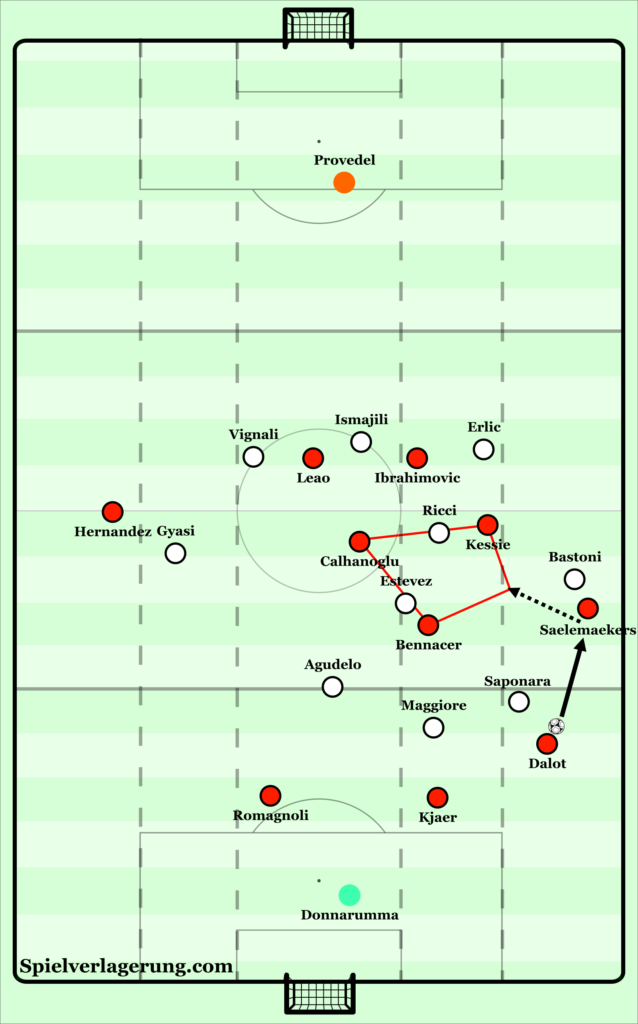
While Milan do prefer to build-up through patient playing out from the back, the abilities of Ibrahimović also allow them to play more direct when they wish to do so, a useful tactic when under pressure, lacking passing options in deeper areas or simply to create quicker attacks into forward areas.
As shown below with an example against Bologna, with Donnarumma in possession just outside of his area, he opts to play direct into Ibrahimović rather than playing out from the back (providing a variant on most of Milan’s build-up). Upon the trigger of Donnarumma (or centre-backs who can also play this ball) shifting possession out of his feet, Milan’s attackers will make runs from their wider positions into narrower areas as to congest the areas around the ball. If they did not do this, it would isolate Ibrahimović and reduce the probability that Milan will secure the knock-down/second ball.
Away from the direct influences upon possession, rather than being more adventurous, Hernández and Calabria tuck-in as possession in its current state is unsecured. Whilst Kessie/Tonali step forward to congest central areas even further, with Romagnoli/Tomori quickly stepping up to maintain a position just inside their own half.
These actions ensure that Milan have congested central areas and provides them with a basis to counter-press should Ibrahimović be unsuccessful in securing possession and linking up with Rebić/Leão/Saelemaekers. If they didn’t do this, Milan would be vulnerable in defensive transition with significant distances between players and units for Bologna to exploit (this is an issue Milan have anyway, to be explored further later).
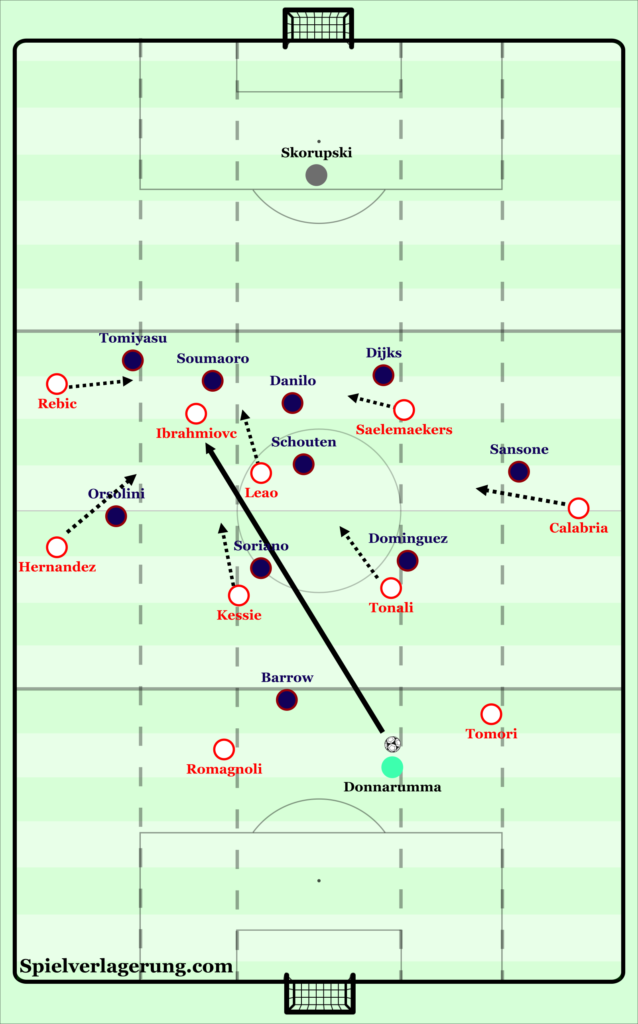
As a result, once possession has reached Ibrahimović, who more often than not beats his opponent, Milan are in a position with Rebić/Leão/Saelemaekers to combine in tight areas and generate attacking momentum.
At times Leão will drop deeper to secure a knock-down from Ibrahimović in-front of him and play forwards (often when Ibrahimović has less pressure upon him and has more control over possession), whilst in this instance Leão makes a 3rd man beyond him, as Ibrahimović is in less control and can only flick the ball on, to create a 3v3 against Bologna’s last-line in combination with Rebić/Saelemaekers who typically take up positions to the left and right of Ibrahimović respectively.
As such, once Rebić receives the knock-down Milan have gone from their own defensive third to a 3v3 on the last-line within two passes, allowing potential follow-up actions of quick combinations between the trio and forward runs beyond Bologna’s defensive line to create scenarios in which Milan can conceivably create goal-scoring opportunities within a matter of seconds.
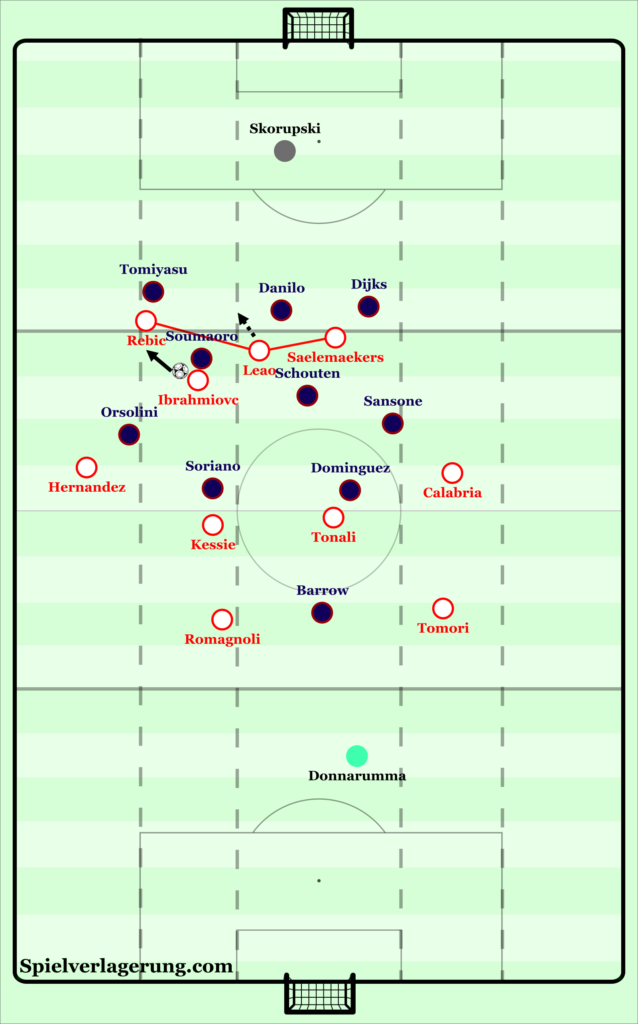
Free-Flowing Attacking Play
As shown in the first section, a significant proportion of Milan’s attacking play utilises the advancement of full-backs, particularly Hernández, thus warranting a focus upon how he benefits Milan’s attacking play in the half-space or widest lane.
The trigger for Hernández’s involvement is suitably the securing of possession by the front-four, from which he aggressively makes forward runs into advanced areas in order to influence the attack. In the example below, this follows a flick-on from Ibrahimović with Leão securing possession in the widest lane and driving towards Bologna’s back-line. As such, Hernández makes a direct run from his deeper position through the left half-space and between the near-side centre-back and full-back, creating a 2v1 against Tomiyasu. The detail on his forward runs are vital, with explosive speed and acceleration limiting deeper opposition (wide and central-midfielders) from tracking him in progressive attacks, in this instance both the recovering Danilo and deeper Schouten are behind Hernández when he underlaps Leão.
Whilst Leão/Hernández isolate Tomiyasu, Rebić has tucked inside to occupy the space vacated by Leão whilst both he and Saelemaekers make runs across one another as the attack is progressing in an attempt to disrupt Bologna’s defensive structure. The first intention of this is to draw either Soumaoro or Dijks out of position as if they did it would create a gap for Leão to slide a penetrative pass beyond Bologna’s last-line and thus a clear opportunity to score. However, it also has the by-product of fixing Soumaoro/Dijks on the far-side of play which creates distance between Soumaoro and Tomiyasu (with Danilo recovering) for Hernández/Leão to exploit in a 2v1.
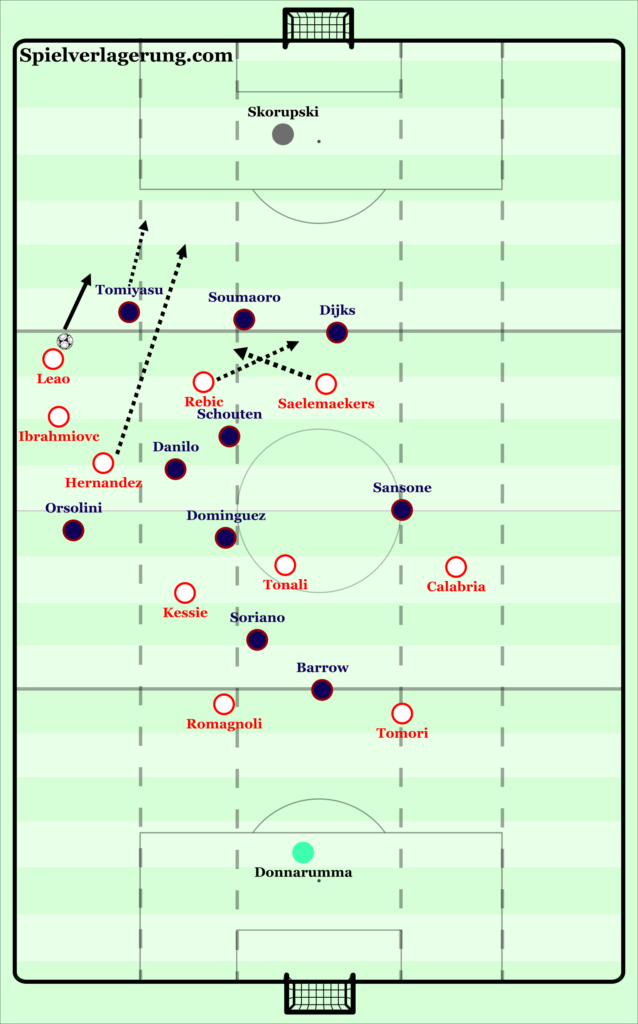
As a consequence, with Tomiyasu given no option but to delay Milan’s attack (as he is underloaded and if he engages he was simply be played beyond) once Leão reaches Bologna’s penalty area and upon the timing of Hernández progressing past him he has two available options. He can play to Hernández who will have the subsequent ability to cross/cut-back into Rebić/Saelemaekers or he can use Hernández as a decoy, with him drawing the attention of Tomiyasu/Danilo/Schouten (Danilo/Schouten follow Hernández’s run), to cut inside himself and shoot. He chose the latter and saw a shot saved by Skorupski, though in theory it wasn’t the best option with Hernandez beyond the last-line and Rebić/Saelemaekers in a 2v2 at the far post.
Regardless, this exemplifies the influence Hernández has upon attacking play from deeper areas, able to draw players out of structure and create moments for Milan’s attackers to exploit. This scenario is also regularly replicated with Hernández overlapping when players cut inside, which opponents should also be aware of.
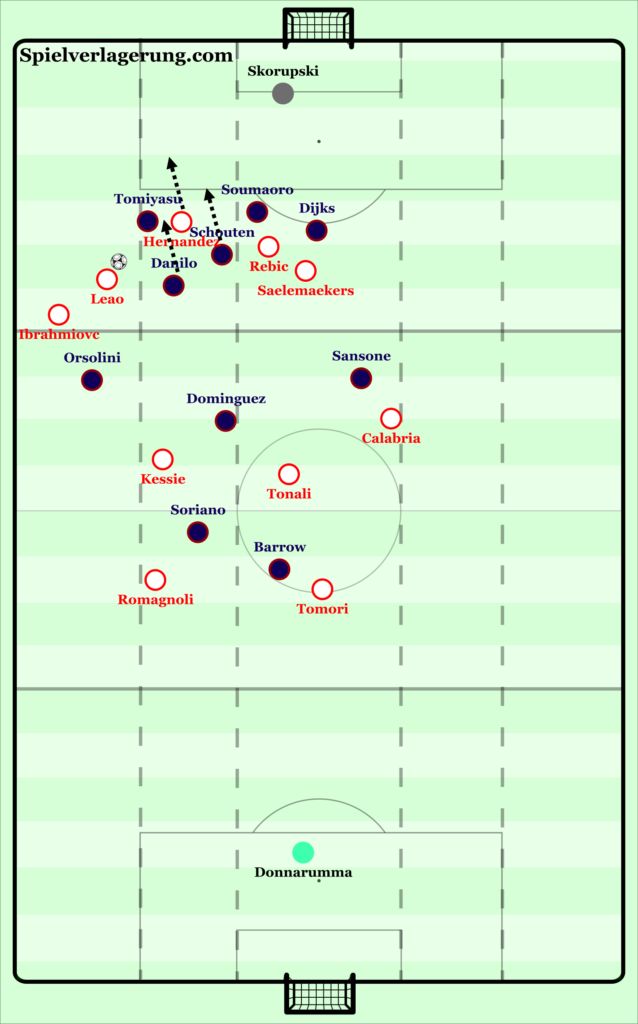
Although, this somewhat fails to appreciate the extent of freedom that Hernández has in attacking exploits, with the highlighted scenario against Roma a further representation of the freedom extended to Hernández to take-up central positions on the opposition’s last-line, often becoming the 5th attacker.
As depicted below, following a regain initiated byHernández’s press against Karsdorp, with him travelling to be “in contact” as Karsdorp received thus forcing a mistake that falls into the path of Ibrahimović, Hernández makes an aggressive forward run to exploit space with similar detail to the prior example with his directness restricting Roma’s players from recovering (though being in attacking transition admittedly did help in this scenario).
However, rather than being restricted to wider/deeper areas (if this was the case, Rebić/Çalhanoğlu would take up central space with Hernández wider) with Ibrahimović in a wider position, Hernández takes up a central position along Roma’s last-line to enhance the potency of Milan’s attacking play (becoming Milan’s highest player in the process). It must be said, that if one of Çalhanoğlu/Saelemaekers/Rebić were in an advanced central position it is unlikely that Hernández would take up this position, yet his attacking intent to do so expresses his influence upon attacking play.
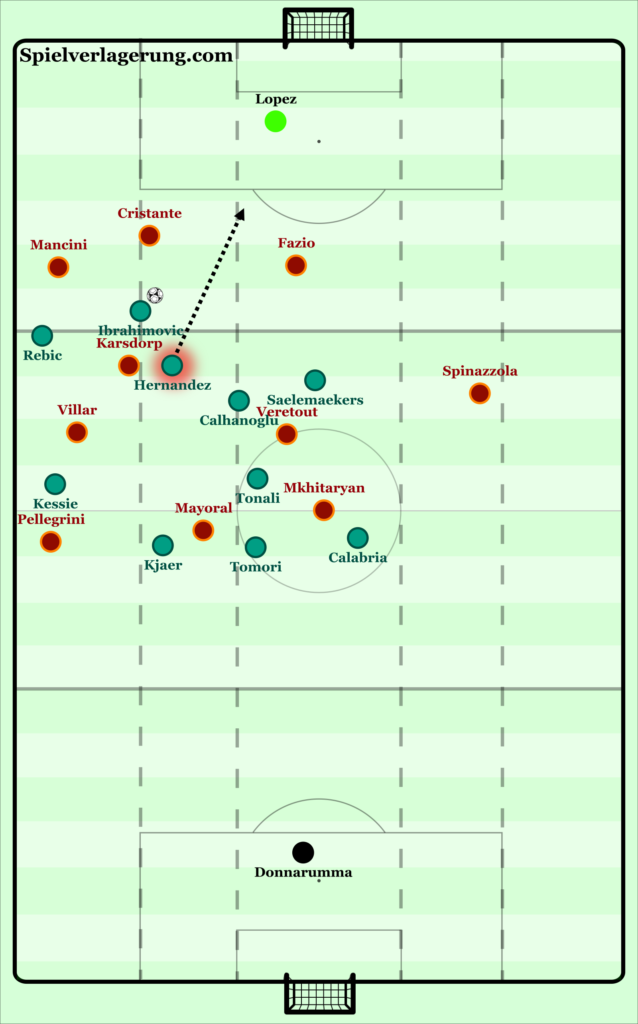
Therefore, as Ibrahimović travelled forwards with possession, this allowed Milan to create a 2v2 centrally on Roma’s last-line with Hernández/Saelemaekers against Fazio/Cristante with Mancini drawn out by the ball-carrier, isolating the duo. From here, Ibrahimović could have either played into Hernández who was marked closely by Cristante or Saelemaekers who had pulled away from Fazio with a checked movement with an intention to receive deeper and perhaps get a strike on goal. Ibrahimović chose the former and was able to play into Hernández, who received on his front-foot to prevent an interception from Cristante, and play a one-two return with Ibrahimović creating a 3v2 with his forward run, forcing a good save from López with his first time shot.
Furthermore, there have also been examples of Hernández maintaining this central position in similar scenarios even when possession goes wide, enabling Milan to deliver crosses/cut-backs into the penalty area whilst maintaining equal or even overloaded situations in the box, compounding Hernández’s status of Milan’s most frequent 5th attacker.
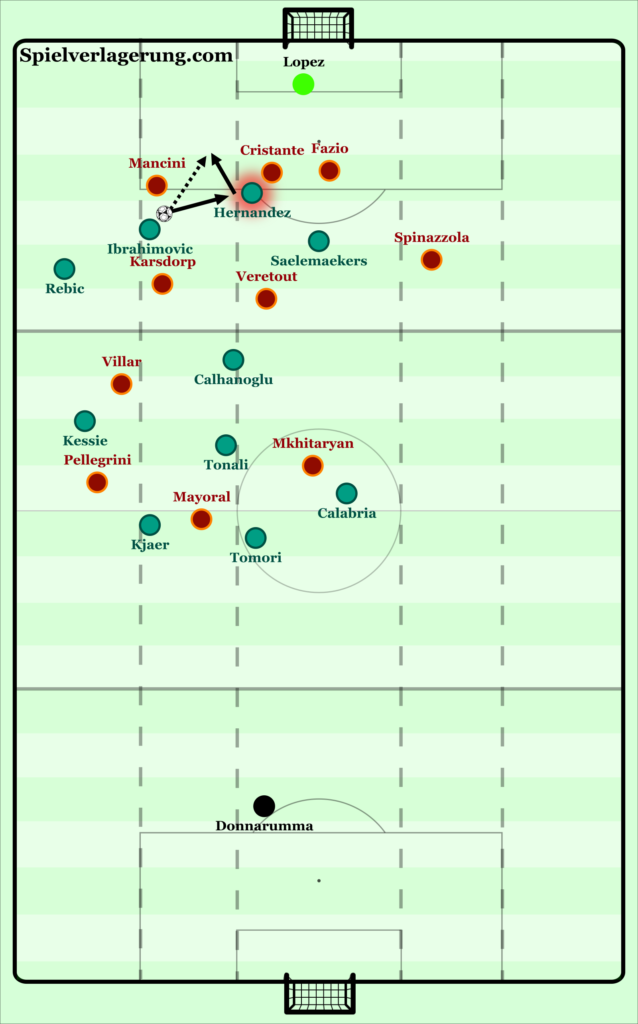
The fluidity of Milan’s attacking play extends to their rotations, with two frequent rotation patterns evident in their play (other than the natural interchanges that happen between the front-four when they congest in narrow central spaces).
The first of which is portrayed below, with Ibrahimović dropping extremely deep in an attempt to receive and link-up possession, whilst also creating space beyond for forward runs to penetrate beyond Bologna’s last-line. As Tomori steps forward and draws out Bologna’s first line, Ibrahimović drops deep into the vacated space between Bologna’s attacking and midfield line, with Soriano/Dominguez remaining behind possession as this pass is played with them occupying Kessie/Tonali in deeper positions to prevent earlier passes into them during the first phase of build-up.
Meanwhile, Hernández’s wider position and Rebić’s narrower position attracts the attention of Orsolini and Tomiyasu on the opposite side. Whilst on the near-side, Calabria’s position beyond Sansone creates hesitancy for him to potentially press Ibrahimović, whilst Calabria has fixed Dijks in the widest lane. If either of these were to press with any real intent, it would have presented a direct opportunity for Milan to play beyond and penetrate even easier. In central areas, Leão ensured Schouten couldn’t come across to affect Ibrahimović (whilst Bologna’s lack of central support prevents this anyway) and Danilo remains as the only player to offer Bologna some central cover.
This meant that upon Ibrahimović receiving, Soumaoro felt inclined to press as the nearest man and the only one able to affect play, yet stopped half-way, clearly anticipating the danger that Saelemaekers could cause with forward runs. Though the opportunity to penetrate and play beyond Bologna’s last-line had already been created.
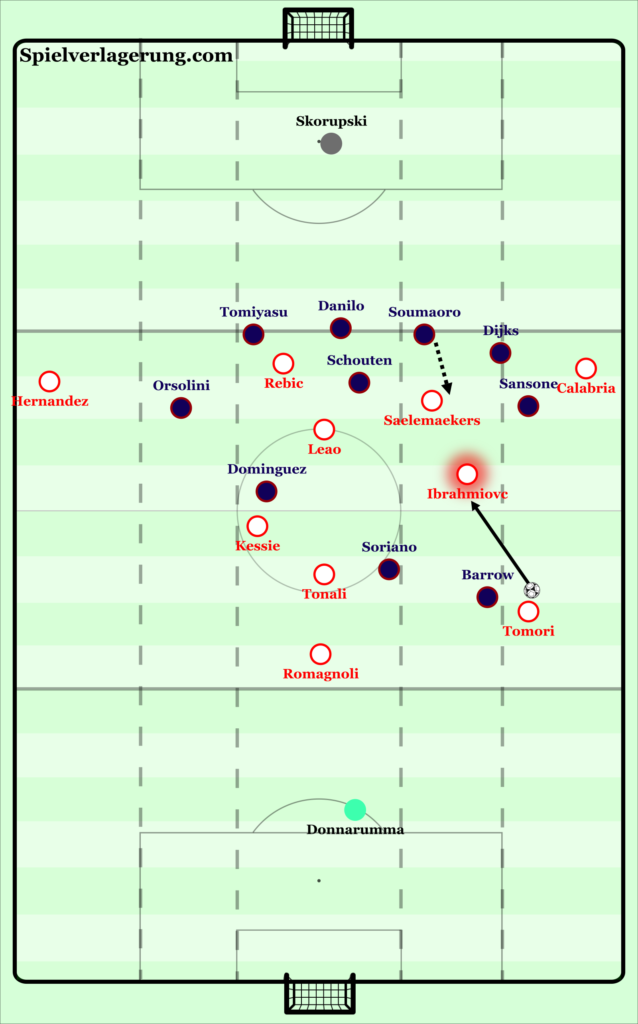
As such, Ibrahimović played a clipped pass beyond Dijks with Calabria making a forward run into the space beyond in an attempt to penetrate Bologna’s last-line, which would allow Calabria to progress and either shoot or combine with the on-rushing Leão/Rebić.
Additionally, as the ball is travelling with Schouten’s perception taken by Ibrahimović’s pass, Leão is able to make a blind-side run beyond him and create a 3v3 against Bologna’s last-line, with Calabria wider and Rebić already positioned between Danilo/Tomiyasu. This is compounded when also considering the forward run that Hernández is making on the opposite side, untracked by Orsolini.
Once Calabria beats Dijks in the aerial duel which takes possession into Rebić, he continues to travel inside past Dijks (with Ibrahimović’s straight pass lacking the sufficient weight to penetrate beyond the last-line), meaning Milan have created an overloaded scenario against Bologna’s remaining defenders and have presented themselves with a good opportunity to combine and create a goal-scoring opportunity. Of course, if Bologna’s players were more structured and composed in following blind-side runs and staying in a compact structure this opportunity was unlikely to arise, nevertheless this is the evident intention of Ibrahimović’s movement and successful in this instance.
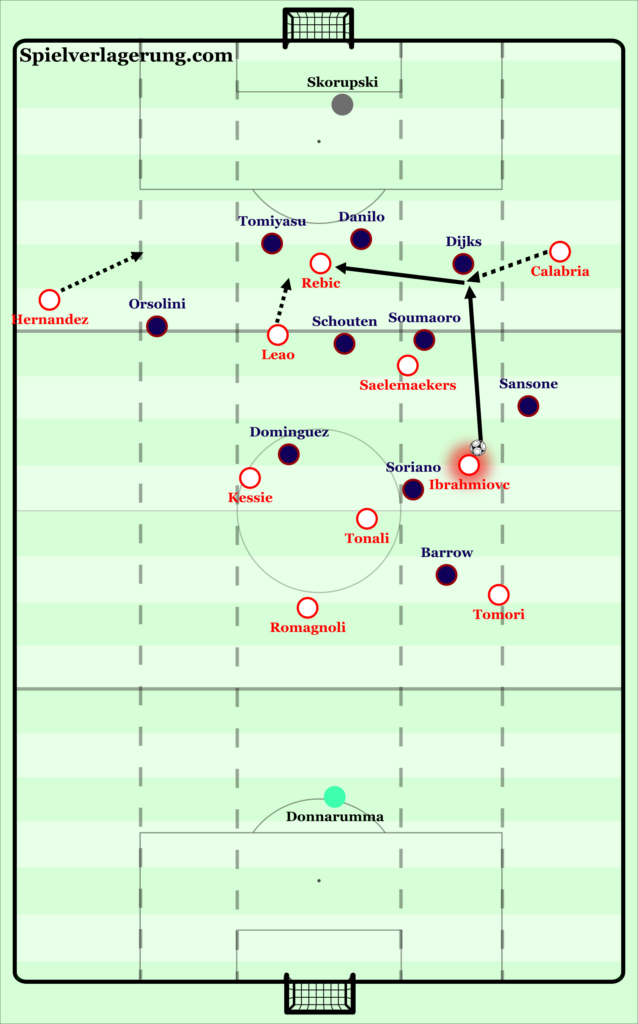
The other frequent rotation pattern ensures central-midfielders become a significant component of Milan’s attacking play, using them in rotations to exploit the opposition through 3rd man runs within wide triangles. The intention as with the below instance against Spezia, is to disrupt compact opposition structures and create space to penetrate opposition lines (whilst these rotations would also be suitable against man-orientated pressing approaches).
As in the beneath graphic, with Kjær in possession, Spezia are organised into an extremely compact mid-block with the widest lane and half-space congested by Bastoni marking Saelemaekers and Saponara in a narrow position enabling him to press in-out upon any pass into Dalot. Whilst Kessie, the near-side midfielder, is marked by Ricci preventing Milan’s progression in wide areas.
There is potential for Milan to play centrally, with Çalhanoğlu in free space as his likely marker Vignali has dropped to retain Spezia’s defensive line (as shown earlier in the piece, Spezia’s nearest man in the last-line will step in to occupy any opposing extra man). Though, if Kjær did shape his body to play inside, it is extremely likely that Vignali would step forward to aggressively engage whilst Ismajili retains defensive cover with support from the higher Agudelo allowing Spezia the chance to regain possession.
To counter this, upon the trigger of Kjær passing into Dalot (who has an open body orientation widening his perception to play into players inside), Kessie and Saelemaekers rotate positions to create a temporary opportunity to penetrate with Saelemaekers luring Bastoni out of position and Kessie making his 3rd man run from the blind-side of Ricci to prevent his ability to recover.
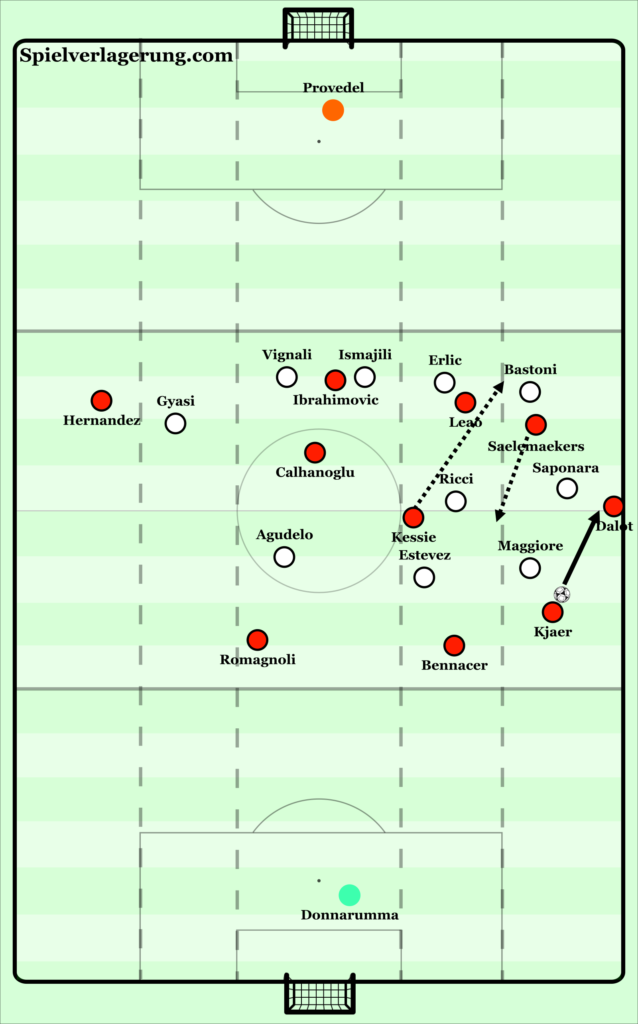
Consequently, as Dalot receives he has two available follow-up actions. If he chooses to play directly into Kessie then Milan have the opportunity to progress in the widest lane and break Spezia’s midfield line in the process with Leão able to support. Alternatively, he can play into the deeper Saelemaekers who is able to retain possession back to Bennacer (creating space by drawing in Spezia’s midfielders to shift possession horizontally before playing into space on the opposite side of midfield) or more adventurously play an “around the corner” pass into the aforementioned run by Kessie.
Dalot chose the second option, likely due to the delayed timing of Kessie’s run preventing him from accelerating into space before Saponara adjusted to cut off passes down the line. Despite this, with Saelemaekers drawing in pressure from Estévez, Milan were able to shift possession across into Romagnoli who could play into the now much deeper Çalhanoğlu. The extent of his depth restricting Vignali from tracking him, as if he did it would provide Milan with a clear opportunity to penetrate beyond the last-line with Hernández well positioned to exploit this space through a more direct pass.
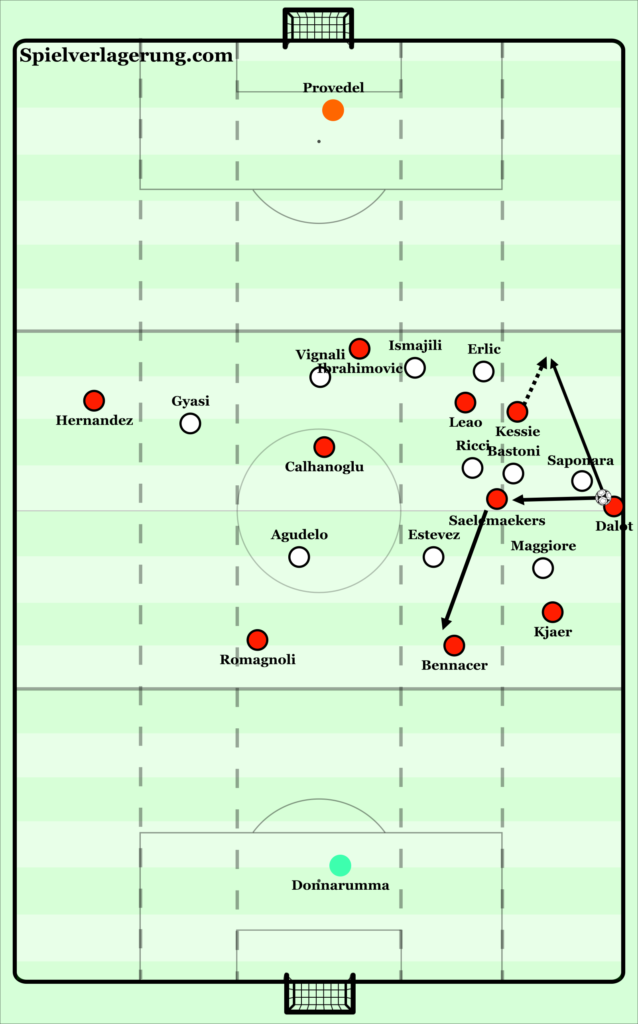
Defensive Inefficiencies
Although, in spite of Milan’s fluid and impressive displays when in possession, their recent performances have amplified some significant defensive inefficiencies of which have been exposed on numerous occasions, particularly against their domestic rivals. It is logical to first begin with their passive press, shown to be ineffective and escapable against both Spezia’s back-four and Inter’s back-three, before moving on to an equally concerning vulnerability in defensive transition.
With Spezia displaying an example of Milan’s press against a back-four, they are able to exploit Milan by creating a 3v2 to play out in wide areas. As Provedel is in possession centrally, Ibrahimović begins closer to Erlic aiming to force play into Ismajili as the opposite centre-back, whilst Çalhanoğlu is deeper centrally and front-screening Ricci to prevent Spezia from penetrating centrally (if Ricci was able to create a passing lane to receive he would break Milan’s press immediately). In wider areas, as play is being forced to Milan’s left, Saelemaekers tucks narrower to retain compactness yet maintains a position to travel if a pass is attempted into Bastoni, whereas Leão is positioned half-way between Ismajili/Vignali (presumably so he is in a position to press Ismajili either alone or in combination as a double-press with Çalhanoğlu).
In deeper areas, Maggiore and Estévez take up high positions to drag out Kessie/Bennacer in central-midfield, whilst Gyasi/Agudelo/Saponara remain higher to fix Milan’s back-line. Importantly, Gyasi remains high and wide to fix Hernández and prevent him from moving higher to press, as if he did and was unsuccessful it would allow Spezia space to progress beyond Milan’s last-line.
As a result of this and with Leão in an unsuitable position to recover a clipped pass into Vignali (if he started closer to Vignali he would likely prevent this and the subsequent escape of Milan’s press), Provedel can play this pass with ease whilst Kessie attempts to press yet cannot cover the distance required due to Estévez’s higher positioning, allowing Vignali to play quickly inside into Estévez who was left unmarked by Kessie’s prior movement.
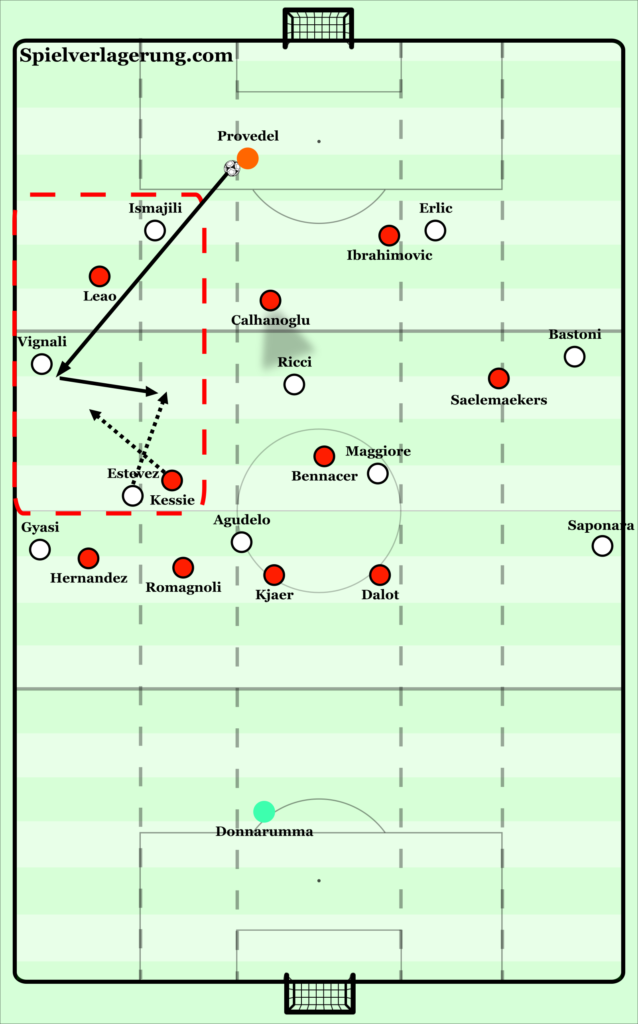
Following this, with Estévez afforded the space to travel and progress past Milan’s midfield line, he can play a diagonal switch of play into Saponara who made a forward run beyond the back shoulder of Dalot in an attempt to penetrate Milan’s last-line. Furthermore, with Maggiore making a run in-between Kjær/Dalot and Agudelo positioned between Romagnoli/Kjær, Dalot has an issue developing as if he remain narrower then Saponara will have space to exploit in wider areas yet if he moves to engage Saponara then Maggiore has the ability to be playing in behind Milan’s defensive line (effectively the nature of defending under loaded in a 2v1). In summary, Spezia were able to bypass Milan’s press and create an attack within three passes to play beyond Milan’s last-line.
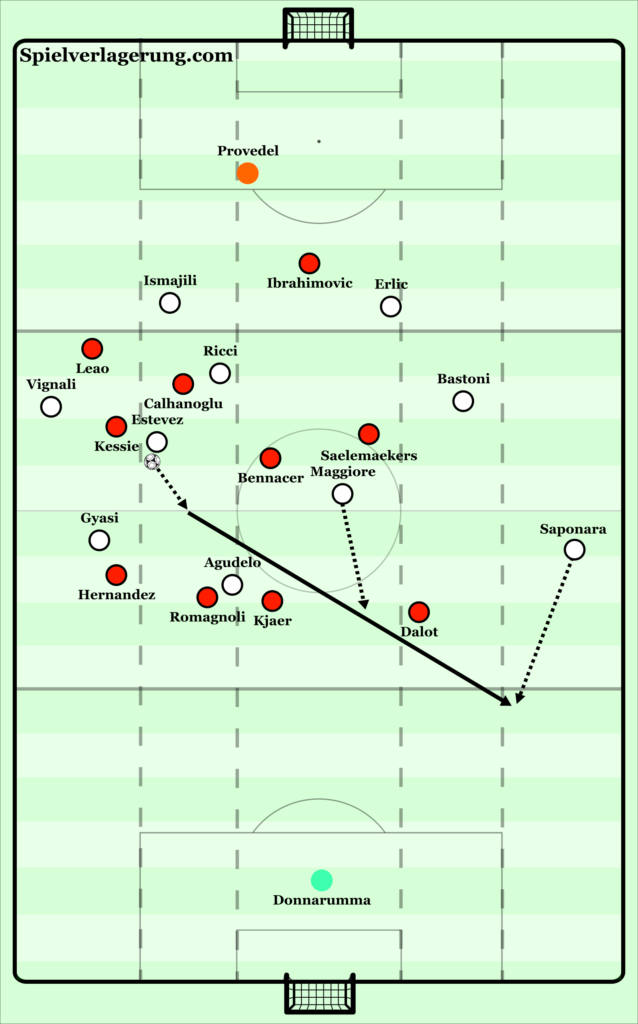
Milan have also been exposed centrally, with Inter able to exploit them in an even simpler manner with only one pass necessary by using Martínez to create an overload in central-midfield and draw Kjær out at the same time.
As illustrated below, Ibrahimović engages upon Handanovic whilst keeping de Vrij in his cover-shadow, with Saelemaekers and Rebić in narrower positions to press in-out upon the trigger of any passes into Bastoni/Skriniar respectively. In central-midfield, Çalhanoğlu marks Brozović whilst Tonali has been drawn into a much higher position than usual in order to mark Eriksen (both remaining “in contact” as if they didn’t, Inter would be able to play directly into midfield). Kessie remains in a deeper position to mark Barella who is located within the right half-space and to prevent Inter playing a second line pass to penetrate, creating a vast vacated space in the centre of the pitch.
Milan’s back-line, remain in a 4v4 with Perisić/Hakimi at wing-back pinning Calabria/Hernández and similarly in the centre, Lukaku/Martínez ensuring they are marked respectively by Romagnoli/Kjær. Using the vacated midfield space as a cue to create an overload in build-up, Martínez accelerates from his higher position to receive centrally and create enough distance to receive without immediate pressure from Kjær to ensure Inter can play beyond Milan’s first line. Kjær attempts to track Martínez’s run, as if he didn’t Milan’s pressing approach would be broken and him doing so retains an opportunity for Milan to regain possession higher up the pitch, though Martínez’s speed ensures he dismarks from Kjær and upon receiving is able to turn, face Kjær up 1v1 and with a sharp drop of the shoulder to the right puts Kjær off-balance, allowing him to progress beyond him.
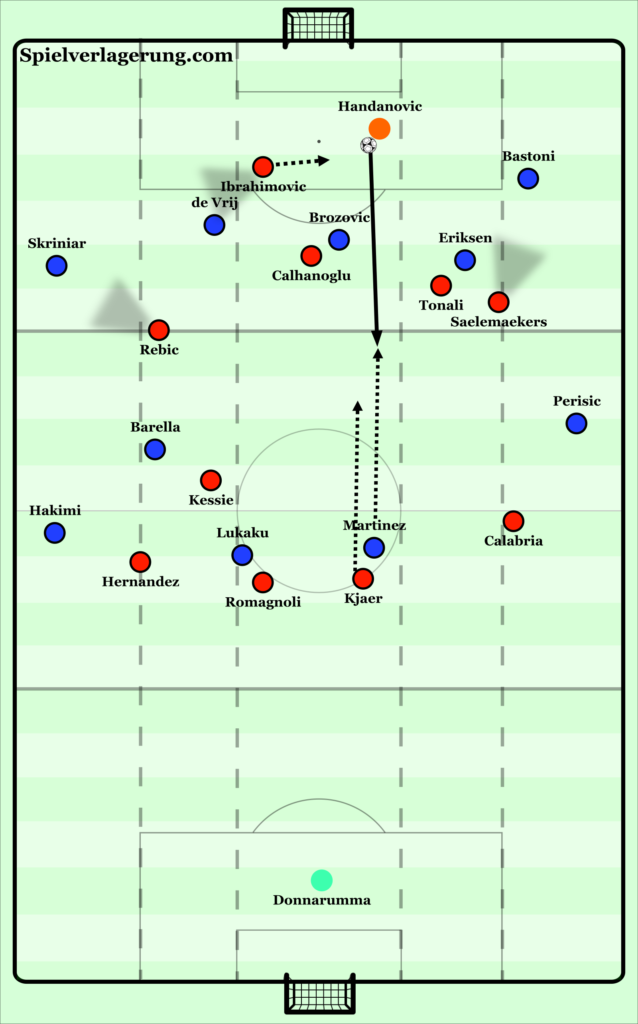
This allowed Martínez to travel towards Milan’s half, with a developing 4v4 ahead (extended if considering the forward run Barella is making). Lukaku made a run across Romagnoli, and in-between Romagnoli/Calabria (where he found lots of success throughout the match, by simply making runs outside of Milan’s centre-backs to expose Romagnoli/Kjær’s lack of pace). In wider areas, Hakimi/Perisić also remained viable options to play into who could in-turn either attack full-backs or deliver into the aforementioned run by Lukaku. Therefore, with the scenario progressing, Kjær chose to bring Martínez down from behind and was duly given a yellow card only minutes into the Milan derby.
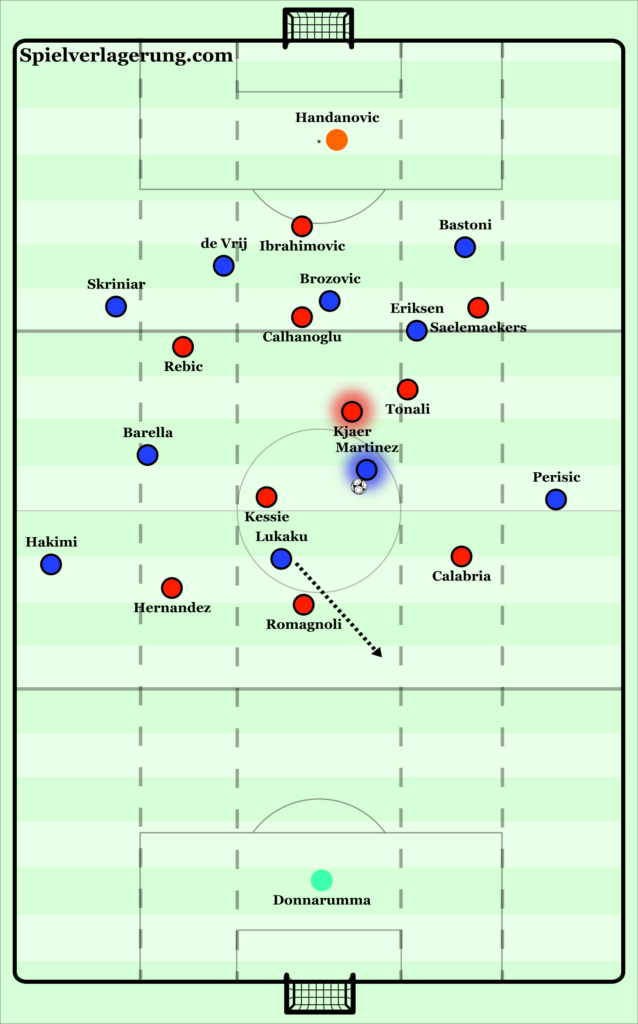
Equally concerning to Milan’s inefficiencies within their pressing is the number of times they have been exposed in defensive transition, demonstrating the negative trade-off that is associated with Hernández’s attacking exploits. This is portrayed below against Atalanta, with wing-back Hateboer able to make forward runs upon the immediate trigger of Milan losing possession in the final third when Hernández has advanced (it also remains a viable strategy for opponents without wing-backs, it would just be implemented by either full-backs or wide-midfielders dependent upon the nature of the formation).
Following a poor pass from Hernández who had advanced to the edge of Atalanta’s area, and a header away that fell to Ilicić, Milan found themselves in a defensively unbalanced position with exploitable space in the deeper left full-back area (where Hernández would be positioned or if less adventurous, able to recover into quickly). If either Tonali/Kessie remained slightly deeper, Milan would be able to defend this transition with a balanced back-three across the three central lanes with the other applying pressure to delay the attack, yet as is frequent they both find themselves in a position unable to recover effectively.
Due to this, Ilicić was able to release a pass quickly across into Gosens under pressure from Kalulu, again whom if he had stayed in structure rather than counter-pressing would have helped to preserve Milan’s defensive structure, which enabled him to play directly over the recovering Tonali/Kessie and into the path of Hateboer. It is also appropriate to highlight that with Calabria occupied by the run of Pessina and Kjær by Zapata in-front of him, there is no opportunity for them to shift across to intercept this pass as if they did Atalanta would be able to play into either Pessina/Zapata who could progress into the space created to penetrate.
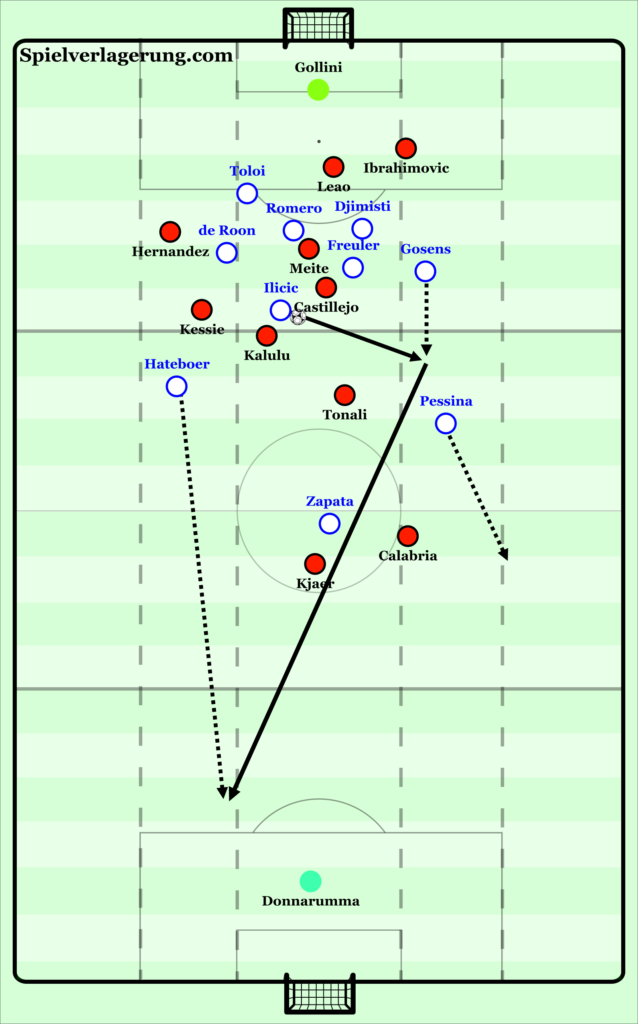
Upon successful reception of the pass, Atalanta were able to create a 2v1 (2v2 including Kessie) from which Hateboer was able to travel inside and take a deflected shot towards goal which only just went wide (with his hesitant control allowing Kessie to recover and also limiting his ability to travel even closer to goal). If this control was able to take possession across Kessie and/or the player released was quicker, then it would’ve been more dangerous for Milan with an undeniable 2v1 against Kjær available. Alternatively, there could have been the opportunity to cross/cut-back into Zapata centrally who has isolated Kjær in a 1v1. As such, this shows a further weakness from which Milan’s opponents can look to expose.
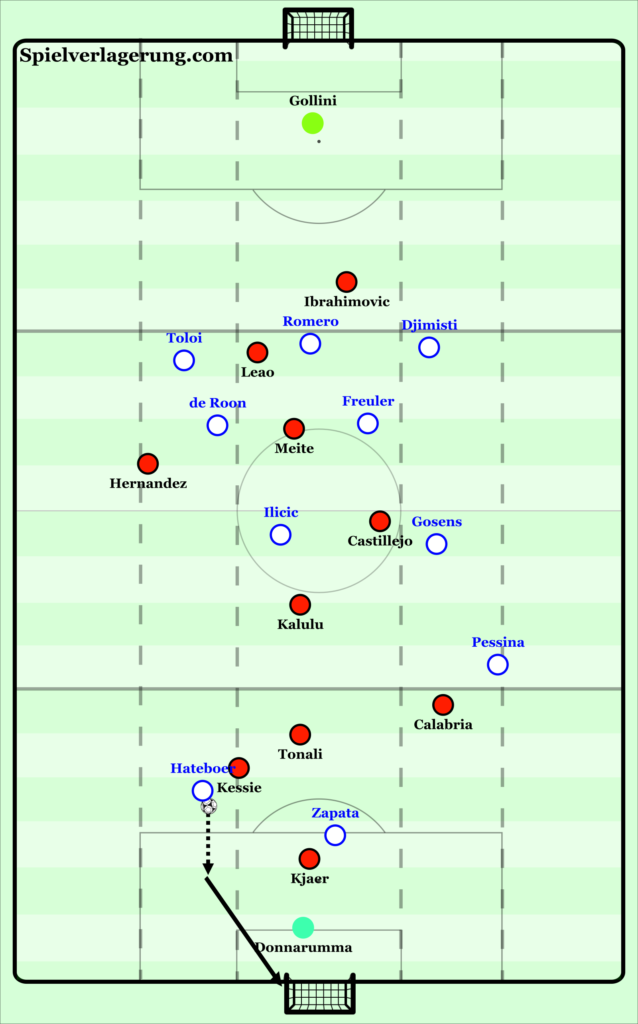
Conclusion
It is clear that Pioli’s implementations in Milan’s attacking play have made the Rossoneri a force to be reckoned with once again, employing a multiplicity of strategies in possession ensuring that Milan carry a threat against any opponent. However, there remain some clear areas to improve out of possession, with a particular vulnerability in defensive transition and whilst pressing to regain possession higher up the pitch may be preferred, a more compact approach may be suitable in clashes against the European elite, especially considering the heavy defeats Milan have succumbed to against Atalanta and Inter in recent weeks. Nevertheless, it is exciting to see Milan competing on both a domestic and European stage yet again, but the challenge for Pioli now is to maintain this progression, whilst it will be intriguing to see how they compare to Manchester United in their upcoming Europa League tie and also how they finish in an increasingly tight Serie A.
[ad_2]
Source link

